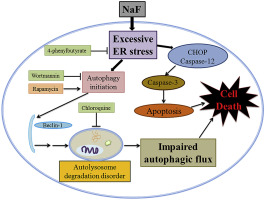Environmental Pollution ( IF 7.6 ) Pub Date : 2017-10-31 , DOI: 10.1016/j.envpol.2017.09.015 Qiang Niu , Jingwen Chen , Tao Xia , Pei Li , Guoyu Zhou , Chunyan Xu , Qian Zhao , Lixin Dong , Shun Zhang , Aiguo Wang

|
Fluoride is capable of inducing neurotoxicity, but its mechanisms remain elusive. This study aimed to explore the roles of endoplasmic reticulum (ER) stress and autophagy in sodium fluoride (NaF)-induced neurotoxicity, focusing on the regulating role of ER stress in autophagy. The in vivo results demonstrated that NaF exposure impaired the learning and memory capabilities of rats, and resulted in histological and ultrastructural abnormalities in rat hippocampus. Moreover, NaF exposure induced excessive ER stress and associated apoptosis, as manifested by elevated IRE1α, GRP78, cleaved caspase-12 and cleaved-caspase-3, as well as defective autophagy, as shown by increased Beclin1, LC3-II and p62 expression in hippocampus. Consistently, the in vitro results further verified the findings of in vivo study that NaF induced excessive ER stress and defective autophagy in SH-SY5Y cells. Notably, inhibition of autophagy in NaF-treated SH-SY5Y cells with Wortmannin or Chloroquine decreased, while induction of autophagy by Rapamycin increased the cell viability. These results were correlated well with the immunofluorescence observations, thus confirming the pivotal role of autophagic flux dysfunction in NaF-induced cell death. Importantly, mitigation of ER stress by 4-phenylbutyrate in NaF-treated SH-SY5Y cells inhibited the expressions of autophagy markers, and decreased cell apoptosis. Taken together, these data suggest that neuronal death resulted from excessive ER stress and autophagic flux dysfunction contributes to fluoride-elicited neurotoxicity. Moreover, the autophagic flux dysfunction was mediated by excessive ER stress, which provided novel insight into a better understanding of fluoride-induced neurotoxicity.
中文翻译:

过度的内质网应激和由此导致的自噬通量功能障碍导致氟化物诱导的神经毒性
氟化物能够诱导神经毒性,但其机理尚不清楚。这项研究旨在探讨内质网(ER)应激和自噬在氟化钠(NaF)诱导的神经毒性中的作用,重点是ER应激在自噬中的调节作用。该体内结果表明,氟化钠曝光损害大鼠的学习记忆能力,并导致大鼠海马组织学及超微结构异常。此外,NaF暴露引起过度的ER应激和相关的细胞凋亡,这表现为IRE1α,GRP78升高,caspase-12裂解和caspase-3裂解以及自噬缺陷,如Beclin1,LC3-II和p62表达增加所表明的。海马。一致的是,在体外结果进一步证实了体内的发现研究表明NaF诱导SH-SY5Y细胞过度内质网应激和自噬缺陷。值得注意的是,用Wortmannin或氯喹抑制了NaF处理的SH-SY5Y细胞的自噬作用,而雷帕霉素诱导的自噬作用则增加了细胞活力。这些结果与免疫荧光观察结果很好地相关,从而证实了自噬通量功能障碍在NaF诱导的细胞死亡中的关键作用。重要的是,在NaF处理的SH-SY5Y细胞中通过4-苯基丁酸酯减轻ER应激可抑制自噬标记物的表达,并减少细胞凋亡。综上所述,这些数据表明,过度的内质网应激和自噬通量功能障碍导致的神经元死亡导致氟化物引起的神经毒性。此外,自噬通量功能障碍是由过度的内质网应激介导的,










































 京公网安备 11010802027423号
京公网安备 11010802027423号